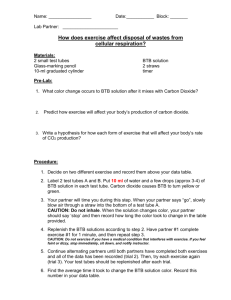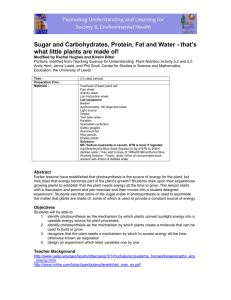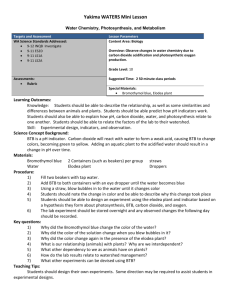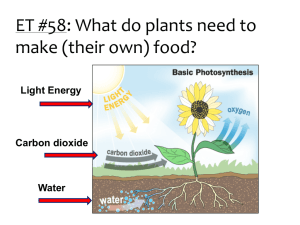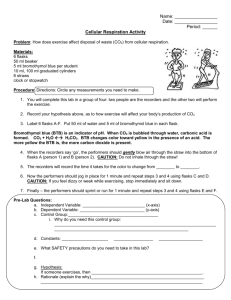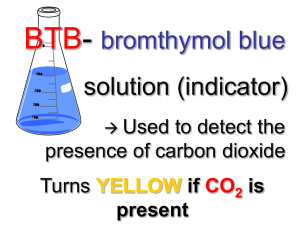Injecting Inquiry into Photosynthesis Investigations
advertisement
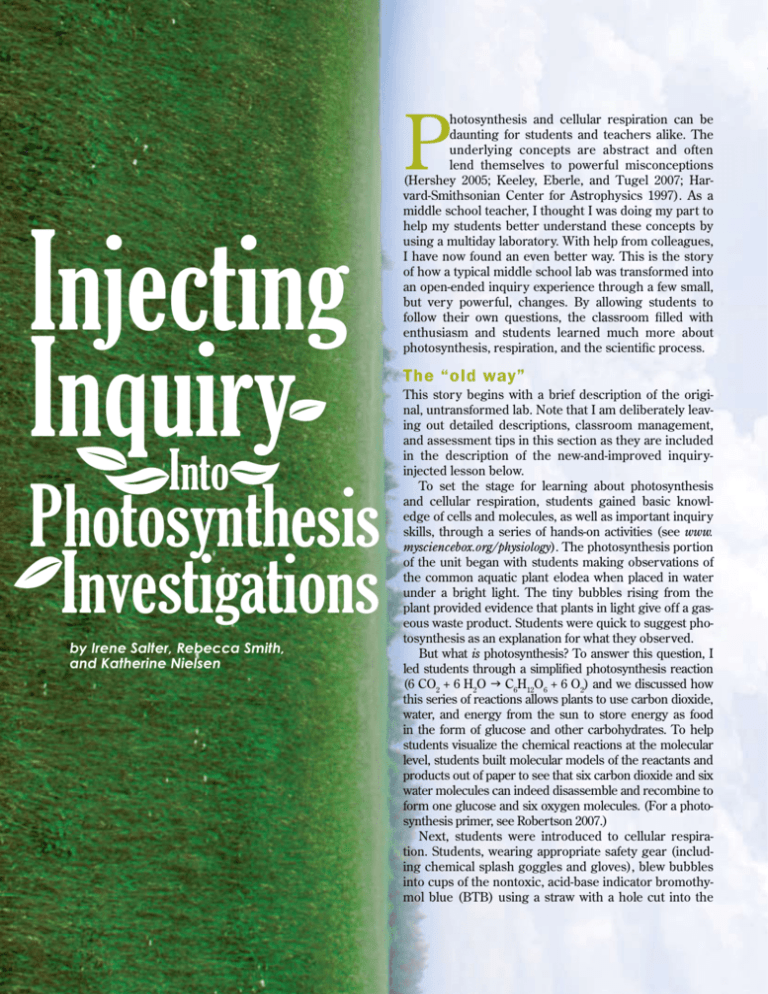
P Injecting Inquiry Into Photosynthesis Investigations by Irene Salter, Rebecca Smith, and Katherine Nielsen 34 SCIENCE SCOPE hotosynthesis and cellular respiration can be daunting for students and teachers alike. The underlying concepts are abstract and often lend themselves to powerful misconceptions (Hershey 2005; Keeley, Eberle, and Tugel 2007; Harvard-Smithsonian Center for Astrophysics 1997). As a middle school teacher, I thought I was doing my part to help my students better understand these concepts by using a multiday laboratory. With help from colleagues, I have now found an even better way. This is the story of how a typical middle school lab was transformed into an open-ended inquiry experience through a few small, but very powerful, changes. By allowing students to follow their own questions, the classroom filled with enthusiasm and students learned much more about photosynthesis, respiration, and the scientific process. The “old way” This story begins with a brief description of the original, untransformed lab. Note that I am deliberately leaving out detailed descriptions, classroom management, and assessment tips in this section as they are included in the description of the new-and-improved inquiryinjected lesson below. To set the stage for learning about photosynthesis and cellular respiration, students gained basic knowledge of cells and molecules, as well as important inquiry skills, through a series of hands-on activities (see www. mysciencebox.org/physiology). The photosynthesis portion of the unit began with students making observations of the common aquatic plant elodea when placed in water under a bright light. The tiny bubbles rising from the plant provided evidence that plants in light give off a gaseous waste product. Students were quick to suggest photosynthesis as an explanation for what they observed. But what is photosynthesis? To answer this question, I led students through a simplified photosynthesis reaction (6 CO2 + 6 H2O g C6H12O6 + 6 O2) and we discussed how this series of reactions allows plants to use carbon dioxide, water, and energy from the sun to store energy as food in the form of glucose and other carbohydrates. To help students visualize the chemical reactions at the molecular level, students built molecular models of the reactants and products out of paper to see that six carbon dioxide and six water molecules can indeed disassemble and recombine to form one glucose and six oxygen molecules. (For a photosynthesis primer, see Robertson 2007.) Next, students were introduced to cellular respiration. Students, wearing appropriate safety gear (including chemical splash goggles and gloves), blew bubbles into cups of the nontoxic, acid-base indicator bromothymol blue (BTB) using a straw with a hole cut into the injecting inquiry into photosynthesis investigations side to prevent ingestion of the solution. They watched with “oohs” and “aahs” as the solution changed from blue to green to yellow. What is going on? BTB is blue in a neutral solution and yellow in a weak acid. When carbon dioxide from the lungs is exhaled into the BTB, it reacts with water to form carbonic acid: CO2 + H2O g H2CO3 Thus one can indirectly measure the presence of carbon dioxide in a solution using BTB. In this original version of the unit, this information is all that students were told. From here, the class was taught about cellular respiration (C6H12O6 + 6 O2 + 36 ADP g 6 CO2 + 6 H2O + 36 ATP) with the use of our previous paper molecule models and discussed how this process allows both animals and plants to take the energy stored in food and convert it to an energy source that cells can more readily use—ATP. If you have time, students can release the energy stored in food as heat by burning food items in a calorimeter (see http://seplessons.ucsf.edu/node/349 for a teacher-generated lesson plan). Finally, we began the culminating photosynthesis experiment. Students were instructed to set up three test tubes. The first two tubes were controls containing unbubbled, blue BTB and bubbled, yellow BTB. For the third, students had a choice. They were told to add blue or yellow BTB, as well as a living thing—elodea, pond snails, or both—to the test tube. The set of three tubes could be placed under bright lights or in a dark closet until the next class period. As students followed the written “cookbook” procedures and completed the prepared worksheet, I felt certain that with built-in controls they would collect some meaningful data. While largely instructor driven, students had an opportunity to make a hypothesis, conduct an experiment, and record and interpret their results in this version of the lab exercise. I expected students to be excited about experimenting with living things and to capably apply their knowledge of photosynthesis and respiration to their observations. Yet students were only moderately enthusiastic about the lab. Most disappointing was that students didn’t know how to interpret their results. For instance, a typical student response was, “The yellow BTB changed to blue when we put a plant in the BTB because [the plant] lets out oxygen.” They knew that a color change meant something happened and assumed that it had something to do with photosynthesis and respiration since that was what we were studying, but few students were able to explain how the color changes they observed provided evidence about changes in carbon dioxide concentration in the solution. Contrary to my expectations, the experience added little to students’ understanding about the cellular processes that were taking place. What went wrong? Although this traditional version of the photosynthesis lab had some elements of inquiry— asking questions, collecting and analyzing evidence, formulating explanations—none were wholly student driven. In my desire to make the investigation “successful” and structure it so that students had solid controls and meaningful data, I had stifled their curiosity. Science education research has repeatedly demonstrated the importance of providing students with as much ownership over their own learning as possible (Bransford, Brown, and Cocking 2000; Olson and Loucks-Horsley 2000). By making the initial decisions about how the experiments should be set up, I inadvertently took away some of that ownership, and as a result dampened their initial fascination with bubbling elodea and solutions that change color when you blow bubbles. The inquiry-injected investigation As I was struggling with ways to improve this lab, I ran into some colleagues who teach a summer biology course to inservice elementary and middle school teachers. This weeklong course, The Architecture of Life, is organized around the key functions of living things and culminates in a participant-driven investigation using many of the materials described above. Through the course, participants gain a deep understanding of scientific content knowledge while being immersed in authentic scientific inquir y. Through discussions with the course instructors, I learned how they facilitate an investigative unit on photosynthesis and respiration with their students. After talking with The Architecture of Life instructors and participating in the San Francisco Exploratorium’s Institute for Inquiry, I made some simple but powerful changes to my original lesson plan. The Exploratorium calls these small but critical changes “subtle shifts” (learn more at www.exploratorium.edu/ifi/workshops/fundamentals/ index.html). The next year, my students and I began the photosynthesis unit the same way—setting the conceptual groundwork, observing elodea as they produced oxygen, and blowing carbon dioxide bubbles into BTB solution. In the original lab, it became clear that students’ understanding of how BTB works needed to be strengthened. By giving students more time to explore with BTB, I found that they can gain a conceptual understanding of both the concept of an indirect indicator generally and how to use BTB as an indirect measure of carbon dioxide concentration specifically. Much like before, students first used the blowing bubbles activity to engage their interest. I then S e p t e m b e r 2 008 35 injecting inquiry into photosynthesis investigations asked the class what they thought was going on (and accepted a wide range of responses). Next, I asked the class to brainstorm how they could test their ideas. Among the tests that can be easily demonstrated at this point are that air (the atmospheric mix we breathe) has no effect on BTB (by placing a hose connected to a fish tank air pump into a cup of BTB), that adding concentrated CO2 (in the form of dry ice) results in the same color change as breathing into the cup, and that you can create the same color change by adding an acidic solution (e.g., vinegar) to the cup. Students then had a short amount of time to investigate their questions and solidify their understanding of BTB. Even with this preparation, it is important to routinely ask students what the color change indicates directly (a pH change), and ask them to explain what they can and cannot conclude from their experiment. Once these fundamentals were established, rather than telling students exactly how to set up their photosynthesis and respiration experiment, I told them that they would have time over the next three class periods to develop their understanding of these processes. I challenged them by saying, “I’ve told you and shown you many things about photosynthesis and respiration over the last few classes. What are you confused about? Is there anything that you aren’t completely convinced of? Get some evidence and see what it tells you. Try to convince yourselves that the photosynthesis and respiration equations are really true.” I introduced students to the materials they could use to explore their ideas. To the materials from the traditional lab (test tubes, BTB, safety equipment, elodea, pond snails, FIGURE 1 36 and different light conditions), I added just a few more items: plastic wrap; plastic storage bags; timers; vinegar; pH paper; and small, hardy fish such as feeder fish, guppies, or goldfish (see Activity Worksheet). The materials were organized on a side counter, buffet style, thus simplifying preparation between classes. If students asked for other materials (food coloring, seeds, soil, etc.), I pulled out what I could from my classroom cabinets. Students were then asked to independently write down questions they had about carbon dioxide, photosynthesis, and respiration on a sheet of paper. Next came the task of sorting students into small groups of two to three. I used a “question walk,” an idea modeled by the Exploratorium. Students placed their questions on their desks and silently walked around the room reading each one. When they found a question that resonated with them, they stood beside it. Students thus self-sorted into inquiry groups based on their interests. In the Architecture of Life course, the instructors collect and review the teacher participants’ questions outside of class and form teams on the basis of interests, while also taking into consideration the personalities of the individuals and their levels of understanding of the topic. This method would also work well in a classroom setting. Before letting the groups get started, we discussed safety, lab/materials management, and the ethical treatment of animals (see NSTA’s position statement on the use of animals in the classroom at www.nsta.org/about/positions/ animals.aspx). All students were instructed to use chemical splash goggles and gloves throughout the lab, whether working with BTB or not, thus simplifying the instructor’s Table of typical experiments and results Experiment setup Typical results Typical interpretation Blue BTB uncovered and left overnight. No change. CO2 levels have already equilibrated with the room air. Yellow BTB uncovered and left overnight. BTB turns more green/blue (lower CO2 level). CO2 levels are beginning to equilibrate with the room air. Elodea in blue or yellow BTB in light. BTB stays blue or turns blue (lower CO2 level). Elodea used up CO2 for photosynthesis. Additional CO2 may be pulled in from the surrounding air as long as tube/beaker is not covered. Elodea in blue or yellow BTB in dark. BTB turns yellow or stays yellow (higher CO2 level). Elodea created CO2 during cellular respiration. Animal in blue or yellow BTB. BTB turns yellow or stays yellow (higher CO2 level). Animal created CO2 during cellular respiration. SCIENCE SCOPE injecting inquiry into photosynthesis investigations job of monitoring safety. To streamline materials management, one team member was appointed the “getter” for the day and would collect materials from the materials counter and clean up the materials counter at the end of class. Any experimental setups that needed to be left overnight were labeled with masking tape and placed in a plastic dish tub set aside for that class period or into a dish tub inside a dark closet. Groups wanting to use snails or fish had to first present their experimental design and expected results to me. This arrangement models how researchers are required to thoroughly justify and get preapproval for animal experiments from university committees before getting started on their work. Finally, students got busy with their explorations and the classroom buzzed with activity. A huge variety of experiments were tried. (See Activity Worksheet for setup and procedure and Figure 1 for a list of common experiments and typical results.) Many students’ questions led them to design the experiment as dictated by the original lab described above, but others set off in directions I had hardly imagined. Some groups wanted to compare the differences among individuals. Did different fish, or for that matter, different people, breathe out different amounts of carbon dioxide? A big surprise awaited the team of students that compared living things (snails) to dead things (a dead bee) and found that both increased CO2 levels. They concluded, “There must have been microbes attached to [the dead bees] that did cellular respiration and released the CO2!” By giving students more choices, learning was differentiated according to each student’s current conceptual understanding. Students struggling with basic knowledge could tackle differences between plants and animals. One advanced group chose to explore whether seeds were alive by using BTB to measure respiration. They suspended peas in cheesecloth over BTB in a closed system and, sure enough, the BTB turned yellow, providing indirect evidence for cellular respiration (and that seeds are alive) through the production of carbon dioxide. As students worked, I circulated, answering questions and giving encouragement. Several students thought that once they gathered results from their initial experiment, they were done. I actively encouraged students to go beyond their first experiment and follow their questions wherever they might lead. For instance, one group found that dipping elodea in very yellow BTB for one minute appeared to bleach the tips of the leaves. What was causing the color change? The group extended their experiment by dipping elodea in blue BTB, bubbled and unbubbled water, in water with yellow and blue food coloring, and in diluted vinegar. Their results suggested that anything acidic caused the leaves to bleach. Why would this be? They recognized that chlorophyll gives leaves their green color and that something might happen to the chlorophyll in acidic conditions. They continued exploring by manipulating the vinegar concentration. Many teams got stuck trying to interpret results and confused “observations” with “interpretations.” I found it very helpful to stop the class midway through their investigations to give them explicit practice interpreting the results of a hypothetical experiment that nobody in that group was pursuing. I used a different hypothetical experiment for each class period based on what students were doing (for suggestions, refer to Figure 1). As a class, we fit our observations into the broader context of what we knew (or thought we knew) about carbon dioxide and living things. We discussed both what can and cannot be concluded from the evidence. For instance, students were tempted to assume that as carbon dioxide levels go up, oxygen levels go down, yet this is not necessarily true and cannot be measured with BTB alone. A variety of summative assessment instruments can be used to assess students’ understanding at the close of the unit—I use a combination of poster presentations, lab reports, and final exams. For their presentations, students were instructed to create a poster with visuals to help them tell the story of their inquiry investigation, starting with their initial question and ending with what they learned. Whereas the class presentations in the traditional lab fell flat and ended early, after the inquiry injection, students were far more comfortable and enthusiastic telling the story of what they did and why. They seemed proud to share what they learned. Moreover, I was no longer the only one asking questions. For example, one team discovered that bubbled BTB left uncovered for several days returned to its original blue state. This team questioned other students who reported that elodea in bubbled BTB also turned the solution back to blue. “Was this just because the carbon dioxide escaped on its own?” they asked. The poster presentations, while not formally graded, provided a valuable opportunity for me to assess students’ ability to use scientific discourse and function as a community of scientists. Without my prompting, students raised the issue of how important controls are in drawing conclusions. Students also turned in individual lab reports describing their questions, investigations, results, and conclusions, which were graded using a rubric. The final exam required students to apply what they had learned about BTB and photosynthesis and respiration to a new experimental scenario. On the exam, I provided students with the BTB color chart we used in class and then asked them to predict what would happen in a hypothetical experiment: “Zinnia started with a tube of yellow BTB. She put elodea into it and left it in a pitch dark S e p t e m b e r 2 008 37 injecting inquiry into photosynthesis investigations FIGURE 2 Sample student posters describing a team’s photosynthesis and respiration experiment closet until the next day. What color do you think the BTB will turn? Will the plant make bubbles? Make a prediction and explain the reasoning behind your idea based on what you know about photosynthesis, cellular respiration, and carbon dioxide.” An alternative form of assessment for this unit is the use of pre- and postchallenge statements like those that are used in The Architecture of Life course to complement the poster presentations. Here, teacher participants are asked to respond to two statements both before and after learning about photosynthesis and respiration (“Plants get their food from the soil. What about this statement do you agree with? What about this statement do you disagree with? Please support your answers with evidence.” “What do most living things use oxygen for? Please address this question and support your answer with as much detail as possible.”). Pre- and postresponses are scored using a rubric and participants demonstrate statistically significant increases in their understanding of these topics after the course. learned firsthand about the importance of experimental variables and controls, and developed a deeper understanding of key scientific concepts—acid-base chemistry, the relationship between carbon dioxide and oxygen, photosynthesis, cellular respiration, and plant and animal metabolism. Yes, it took more class time (four 50-minute class periods instead of the original two), but in those extra hours, students experienced what it is really like to be a scientist, and came away with a far greater depth of understanding about the underlying concepts and the scientific process. n Lessons learned References The effects of inquiry injection were extraordinary. Students were more engaged, asked their own questions, 38 SCIENCE SCOPE Acknowledgments The Architecture of Life course was developed with support from the Howard Hughes Medical Institute and the California Science Project. We wish to thank Patricia Caldera. Jean MacCormack, Erin Strauss, and Kimberly Tanner for their work developing and teaching The Architecture of Life course. Bransford, J.D., A.L. Brown, and R.R. Cocking, eds. 2000. How people learn: Brain, mind, experience, and school. injecting inquiry into photosynthesis investigations ACTIVITY workSHEET Inquiry-injected lab Materials • Test tubes and test-tube racks • Beakers • Small disposable cups • Drinking straws with a hole cut into the middle • Plastic wrap • Aluminum foil • Plastic storage bags • Timers • Chemical splash goggles • Disposable latex or vinyl gloves • BTB (available as a 0.1% solution from most science supply companies) • pH test strips • Vinegar • Elodea (available from most aquarium stores) • Pond snails (available from most aquarium stores) • Small, hardy fish such as feeder fish, guppies, or small goldfish (available from most aquarium stores) • Light and dark environments • Poster paper • Markers • Tape • Scissors • Optional: Dissolved oxygen test tablets (available from most science supply companies for water-quality testing) • Optional: Other materials as requested by students and as available, such as seeds, soil, food coloring, cheesecloth, etc. Safety Bromothymol blue is reasonably nontoxic to humans, plants, and animals, but may cause irritation of the skin, eyes, and respiratory tract. BTB may be harmful if swallowed. It is important to wear chemical splash goggles and gloves when handling BTB. Non-latex gloves are recommended to avoid allergic reactions. The stock solution of BTB is relatively concentrated and should be disposed of in accordance with Expanded ed. Washington, DC: National Academy Press. Harvard-Smithsonian Center for Astrophysics. 1997. Lessons from thin air. Minds of our own. Annenberg Media. Hershey, D.R. 2005. Avoid misconceptions when teaching about plants. California Journal of Science Education 5 (2): 69–84. Keeley, P., F. Eberle, and J. Tugel. 2007. Uncovering student ideas in science: 25 more formative assessment probes. Vol. 2. Arlington, VA: NSTA Press. Olson, S., and S. Loucks-Horsley, eds. 2000. Inquiry and the national science education standards: A guide for federal, state, and local regulations. The diluted solution used in student experiments should be neutralized (green color) and may then be flushed down the sink with tap water. Setup 1.Add a few drops of the concentrated 0.1% bromothymol blue stock solution to each liter of water. If your tap water is acidic, you may wish to use bottled spring water instead. The color should be a rich royal blue, yet diluted enough so that you can still see light and objects through the bottle. 2.Cut a small diamond out of the middle of each drinking straw. This will allow you to blow through the straw but will prevent inhalation or ingestion of any liquid up through the straw. Procedure 1.Challenge students to investigate what they think they know about BTB, photosynthesis, and respiration. Invite them to ask questions and prove to themselves what they have been told. 2.Introduce the available materials. 3.Ask students to write down questions they are interested in investigating. 4.Organize students into groups of 2–3 using a question walk or by pairing students who have similar questions. 5.Discuss the ethical treatment of animals and require that students with experiments using snails or fish get approval from the instructor for their experiment and hypothesis before beginning. 6.Allow students to investigate freely for at least two hours, spread over two days if possible. Encourage them to write down their questions, observations, and conclusions as they go. 7. Work with each group to interpret their results and to design a presentation for the class. 8.Have each group present their results and conclusions to the class. Allow time for a question-and-answer session after each group has finished. teaching and learning. Washington, DC: National Academies Press. Robertson, B. 2007. How does photosynthesis work? Science and Children 43 (6): 60–63. Irene Salter (isalter@csuchico.edu) is an assistant professor of science education at California State University, Chico, and former middle school science teacher. Rebecca Smith and Katherine Nielsen are co-directors of the Science and Health Education Partnership at the University of California, San Francisco. S e p t e m b e r 2 008 39
